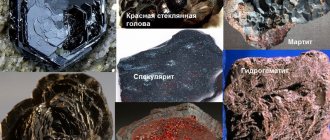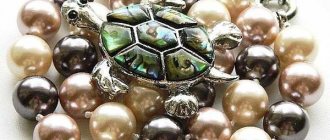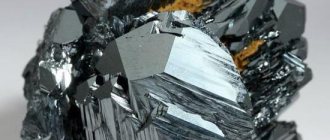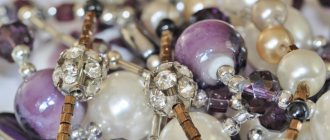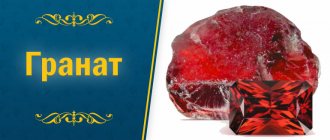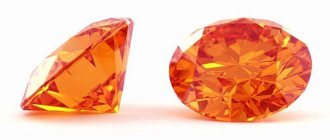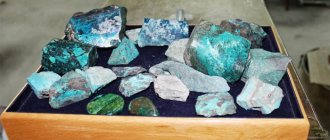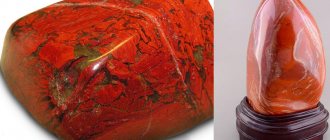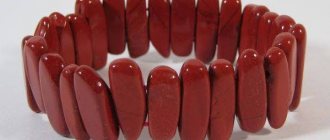History and origin
This mineral has a very long and interesting history. In ancient times, it was believed that hematite beads could be found where a lot of blood had been shed - for example, at the sites of large-scale battles. Then they believed that the absorbed blood of the heroes would turn the water red if the “bloody” mineral was dropped into it.
The mineral received its modern name in the third century BC. It was invented by the Greek poet and philosopher Theophrastus, emphasizing the relationship of the stone with blood, because in his language “hematos” meant “blood”. In Egypt, bloodstone was considered the stone of Isis, the goddess of life on earth. He was credited with the ability to ward off demons.
The Indians rubbed themselves with ground hematite, and that is why they began to be called redskins (in fact, the natural skin color of this race is far from red).
Mirrors were made with the help of bloodstone, and medieval alchemists tried to obtain gold with its help.
In modern times, the stone was forgotten, and only in the seventies of the last century it was discovered that a hematite bracelet was able to normalize blood pressure. So the stone came back into fashion.
Form of being in nature
The shape of the crystals is varied: rhombohedral, tabular - mainly in crystals formed from hydrothermal and gas solutions; isometrically developed crystals are observed (mainly in contact-metasomatic deposits); prismatic crystals are rare. On (0001) there is shading in three directions parallel to the edges (0001): (1011), triangular depressions, also triangular growth pyramids, signs of spiral growth, natural etching, etc.
Doubles
Twins of germination and fusion along (0001) with a fusion plane (1010); twins along (1011) with an angle between basopinacoids equal to 64°48 are very common; Moreover, often small crystals, when growing in a twin position on a larger tabular crystal, are located differently - at an angle of 120° to each other. Twinning may be caused by the pressure experienced by the crystals. Sliding along T (0001), t [1010]. Characteristic are intergrowths of thin-plate crystals (individual plates grow with faces with (0001) almost parallel to each other), composing the so-called iron roses, which may be the result of spiral growth of crystals.
An oriented mutual growth of it and ilmenite (“Washingtonites”) is observed - the result of the decomposition of solid solutions: ilmenite plates are parallel to (0001) or (1011); oriented plates in ilmenite are also noted, oriented parallel to (0001) ilmenite; There are parallel intergrowths of hematite and ilmenite crystals along (0001). Hematite crystals sometimes naturally grow with a (0001) plane on the face of the octahedron of magnetite or spinel; its oriented intergrowths with magnetite are observed under a microscope among the decomposition products of solid solutions: (111) and [110] magnetite in parallel with (0001) and [1010] hematite.
Rutile forms oriented growths on hematite: (100) and (101) rutile parallel to (0001) and (1010) hematite. An oriented growth of pseudobrookite crystals onto hematite crystals was also observed: (121) and [210] pseudobrookite in parallel with (0001) and [1010] hematite; when replacing wolframite: (0001) and [1120] hematite in parallel with (100) and [001] wolframite. Its natural intergrowth with quartz is described: (1010) and [0001] quartz in parallel with (0001) and [1120]. Regular ingrowths of hematite in muscovite were noted with the arrangement of hematite inclusions on (001) mica in three directions at an angle of 60° and the formation of a lattice, which causes the phenomenon of asterism in mica. Acicular inclusions of hematite in corundum with mutually parallel axes of both minerals are known. Regularly arranged hematite flakes are found in carnallite: (0001) and [1120] hematite parallel to (001) and [110] or [100] carnallite; also parallel to (130) and [001] of carnallite; in sylvine: (0001) hematite parallel to (100), (111) or less commonly papal to (110) sylvine; in cancrinite: (0001) hematite parallel to (1010) or (1120) cancrinite; in feldspar, (0001) hematite is parallel to a number of feldspar faces; in calcite (siderite) with hematite ingrowths, the faces (1120) of both minerals are sometimes parallel.
Intergrowths in quartz , microcline, acidic plagioclase and caliber feldspar give these minerals a beautiful sparkling-golden sheen (aventurine, sunstone). Inclusions of the smallest mineral plates color some minerals red (carnallite, sylvite, heulandite, cancrinite, etc.).
Aggregates. Usually found in the form of dense, finely crystalline, scaly or leafy accumulations, as well as in earthy masses and sinter aggregates. In the latter case, it is called red iron ore. Sometimes concentrically layered and radially radiate, sintered, reniform and oolitic.
Leaks. Mineralogical plumb line
Mineral deposits
Hematite
Large industrial deposits of hematite are located in the following areas:
- Russia (in the Komi Republic, in the Irkutsk and Sverdlovsk regions, in Karelia).
- Europe (in Switzerland, England, Czech Republic, Germany).
- Asian countries (Mongolia, Iran, China).
- Africa (in South Africa, Morocco, Algeria).
- USA (Alaska and Michigan).
- Latin America (in Mexico).
- South America (in Brazil and Venezuela).
- Ukraine.
- Azerbaijan.
- Kazakhstan.
Place of Birth
Hematite is found in the Kursk magnetic anomaly area. The ores are represented by martite, formed due to magnetite. In Krivoy Rog (Ukraine) there are ferruginous quartzites containing ore minerals: martite, magnetite, hematite. The upper parts of the Ural magnetite deposits (Mount Magnitnaya, Blagodat, Vysokaya) are represented by martite. In the Lesser Khingan, ferruginous quartzites containing hematite occur among metamorphic rocks.
In the Lake Superior region (USA), hematite is found together with magnetite in metamorphic shales. Oolitic hematite of sedimentary-metamorphic origin is found in Clinton (USA).
Physical properties of the stone
The stone can have a metallic sheen or be matte. There are also differences in density; the mineral can be hard, soft or have an average density. Before processing, the rock in the form of beads and inclusions has the following physical properties:
| Property | Description |
| Formula | Fe2O3 |
| Hardness | 5,5–6,5 |
| Cleavage | Absent |
| singonia | Trigonal |
| Transparency | Opaque |
| Color | Dark red, gray, black |
| Density | 4.9—5.3 g/cm³ |
Physicochemical characteristics
Hematite is a chemical compound of iron and oxygen.
The color of the stone is blue-black with a pronounced metallic sheen and red splashes.
Hematite stone
| Property | Description |
| Formula | Fe2O3 |
| Color | Steel gray fading to black in crystals and massive aggregates, dull; turning into bright red in internal reflections and in dispersed masses. |
| Shine | Metal |
| Transparency | Translucent |
| Hardness | 5 5,5 6 |
| Cleavage | Very imperfect |
| Kink | Conchoidal |
| Density | 4,9-5,3 |
Types of stone
Hematite is a quite diverse stone. Its main types include:
- The red glasshead is the most common species in Europe. It was called the bloodstone because of its dark red color. Often this is the variety that is meant when talking about hematite stone.
Red glass head
- Iron mica is a rock with a scaly structure and a fairly dense crystalline structure. It is interesting for its oily shine, reminiscent of the shine of iron.
Hematite iron mica
- Specularite is a dense mineral with a silver-gray tint, noticeable in bright light. Quite often it contains inclusions of other rocks. It is sometimes classified as a type of iron ore.
Specularite
- Iron rose is a very beautiful and most expensive type of bloodstone. His records are collected in groups that resemble a rosebud. Jewelers use this mineral in jewelry more often than other types of hematite.
Hematite iron rose
- Hematite. A brown and very dense variety of the mineral. Used in iron smelting.
Hematite
- Martite (Mars stone) is the only type that has strong magnetic properties, which is why it is confused with magnetite.
Martit
- Hydrohematite is a mineral containing up to eight percent water. Forms clusters similar to tree buds.
Hydrohematite in adularia
There are other classifications of stone; there are really a lot of varieties. But these are the most common ones.
Type of stone
Natural hematite stone is found in dark red, gray and black colors, regardless of this, if you draw with it, the stripe will always be red.
| Name | Description |
| Hematite | The rock is dense, the structure with small, red inclusions. |
| Iron mica (specularite) | The stone looks as if it is covered with varnish. The surface is scaly, mirror, gray, black. |
| Iron shine | Externally, the mineral resembles united crystals. The color is dark gray, black, the surface has a metallic sheen. |
| Martit | The mineral has loose formations and medium density. |
| Iron Rose | The breed got its name due to the growth of dark crystals in such a way that in appearance they resemble a flower bud. |
| Red glass head | Outwardly it looks like red drops merging into a single mass. |
Also read: Moonstone - the mineral of love and moon people
Rainbow stains are often found on gray and black stones, such as appear in puddles of spilled gasoline.
It is noted that even with the slightest contact of mineral particles with other crystals, it gives pink or orange (rusty) colors. Thanks to bloodstone, sundress, wax and steam jaspers acquired crimson colors.
Hematite healing properties
Hematite-bloodstone
In ancient times, the properties of the stone were attributed to hematite with the ability to influence blood flow and change its composition. It is not surprising that various cultures associated the gem with blood. There were many ways to use the healing properties of the mineral; it was used to quickly heal wounds and stop bleeding. Today, the beneficial properties of this amazing stone can be used regularly, increasing your energy potential with the help of jewelry.
Healing properties of hematite:
- normalizes both low and high blood pressure;
- promotes bone marrow regeneration;
- fights disorders of the genitourinary system, normalizes kidney function, restores reproductive abilities;
- considered a female stone, stops uterine bleeding, relieves painful sensitivity of the cycle, promotes normal pregnancy, increases lactation;
- improves metabolic processes, strengthens the body's protective properties;
- relieves nervous tension, normalizes sleep, charges with optimism;
- stress resistance increases, willpower strengthens, the influence of the “black diamond” helps to quit bad habits and addictions;
- the use of the mineral helps restore the functioning of vital systems;
- stops the growth of tumors and carcinogenic cells.
It exhibits its main healing abilities during the recovery period after operations, a course of treatment, or protracted illnesses.
The composition of the blood changes, the deficiency of microelements is replenished, and chemical parameters are normalized. It is useful to use hematite stone properties to support the liver, kidneys, spleen. The organs perform cleansing functions, removing toxins and free radicals from the blood.
Properties
Widespread iron oxide is our hero today.
Physico-chemical
- The mineral has a very high refractive index. It is higher than that of diamond (3.14 versus 2.42). That’s why the shine of polished hematite is a complete delight.
- It has weak (very weak) pleochroism.
- Iron is iron, but has no magnetic properties.
- It is soluble in hydrochloric acid, but this process takes a long time.
We are treating hematitis
It has been used for medicinal purposes for a long time (and with success). Many properties are associated with the highlight function.
The mineral (according to lithotherapists) heals:
- Prostate diseases.
- Bladder diseases.
- Some sexually transmitted diseases.
- Nervous diseases.
- Protects liver functions.
Hematite powder has been sprinkled on wounds for centuries to stop bleeding.
Lithotherapists advise wearing jewelry or amulets made of hematite after surgery.
Ointments based on the mineral were used for inflammatory processes.
Wearing a ring with a stone stimulates the activity of the spleen.
Caution : lithotherapists believe that wearing jewelry with hematite increases blood pressure.
Bloodstone Magic
- Mars (the lord of hematite) gives courage to the owner of the stone. Therefore, a decoration or amulet with bloodstone will be useful for a person who is weak-willed, shy, or indecisive.
- Do you want to engage in social activities? Be sure to buy a hematite amulet. This stone will make your path to social work easier. By the way, such work will improve your financial situation.
- The pebble will add optimism and help you get out of depression.
- Since ancient times, warriors (especially experienced ones) have carried an amulet made of bloodstone with them. It was believed that the stone not only gives courage in battle, but also increases sexual energy.
Magic of stone
Hematite bracelet
Tribes of hunters and gatherers in the Stone Age used hematite as protection against evil witchcraft. Legionnaires in Ancient Rome took bloodstone on long journeys to protect themselves from injury and ambushes. Not jewelry was used as a talisman, but small figurines of good spirits carved from mineral.
In Rus', children's cradles were decorated with bloodstone. It protected children not only from evil spirits, but also from injuries, falls, and childhood illnesses. In villages, stories are still told about people who were able to avoid encounters with evil spirits thanks to hematite.
The magical country of Shambhala is associated with hematite - this is what they believe in Tibet. Monasteries are often inlaid with it to protect it from unworthy people, and bracelets of the same name are made from the mineral. To those who were able to conquer its power, the bloodstone grants the ability to maintain communication with the spirits of the dead.
Another meaning of hematite is to impart wisdom and the gift of a seer. A gem is capable of revealing to a person the secrets of the Universe. The bloodstone will help fortune tellers and soothsayers - the future will appear before them more clear, clear and definite. So jewelry with hematite will come in handy before a clairvoyance session.
The only advice is that for magical purposes it is best to set hematite in silver.
Jewelry and care
The mineral is used to create beads, bracelets and necklaces. You can often find rings and rings with large hematite stones in the jewelry department. Products framed in gold and silver are popular.
Jewelry with hematite should be wiped with an alcohol solution. Do not try to remove dirt with a sharp object or a hard iron brush. To wipe, you can use a wool or suede cloth. In this case, the stone will retain its shine and will delight its owner longer.
Talismans and amulets
To understand whether the bloodstone is suitable as a talisman, you need to hold it in your hands for several minutes. Having felt a surge of positive energy, there is no doubt that this particular stone will become a reliable friend who will fulfill your innermost desires.
What you need to know:
- A bloodstone worn as a talisman should have a frame made of silver or brass, since these metals help to maximize the capabilities of this stone.
- In order for a ring with hematite to bring luck and happiness, men should wear it on the index finger of their right hand, and women should wear it on their left hand.
- A hematite bracelet enhances sexuality, making its owner more attractive in the eyes of members of the opposite sex.
- Hematite, which imparts courage and courage, will be a good amulet for women and men whose work involves protecting the lives of other people (medics, military, rescuers, firefighters).
- Hematite, which is a symbol of motherhood, should be worn by expectant mothers in the form of a pendant: it will help both the mother and her child avoid dangerous injuries.
- A hematite bracelet is a good amulet that can save its owner from groundless fears and protect him from unwanted influence from the outside.
- Bloodstone can be used as a powerful amulet that can protect a sleeping baby.
- A hematite amulet, worn to protect against damage or the evil eye, is recommended to be carried with you for no more than 7 days. After this time, the mineral needs energetic cleansing.
Magic properties
Since ancient times, the magical properties of hematite were intended for men. They needed it in order not to lose courage and military success, to treat wounds received in battle, diseases “caught” on the love front. It was a magical talisman for warriors.
Mages have never avoided bloodshed. It helps in working with the spirits of the planets, protects the astral warrior from larvae.
In India, hematite was used to concentrate tantric energy.
Hematite jewelry
However, not everyone has the power of the stone. It can destroy the life of a weak owner.
For magical effects, Alaskan diamonds are set in copper.
Used by magicians for proscopy. This is an important and rare ability of magicians to identify past and future events, including health conditions. Bloodstone magic will help here.
Proscopy is not clairvoyance. It can manifest itself in ordinary people - prophetic dreams and premonitions. If you wear amulets or talismans made of hematite, then do not brush aside your premonitions - good or bad. The mineral hematite is woven into the body of the Earth, the information field of the planet. This stone connects its owner with the general field of the planet, with the noosphere. Its existence was brilliantly proven by Vernadsky.
The energy of the stone is masculine; wearing hematite jewelry will help a boy become a real man and gain strength of character.
Esotericists do not advise children under 14 years of age to wear an Alaskan diamond. But the stone is suitable for a man of any age. Its energy strengthens the “core” on which masculine traits rest. Let the man wear a bloodstone amulet on his right side (or a ring with a stone on his right hand).
For a woman, it is better to wear a ring with an iron eye on the left hand, on the index finger.
Before going to bed (preferably 2-3 hours before), jewelry with hematite should be removed.
Many astrologers believe that hematite is an ambitious person. The high social position of the owner is important to him. And wealth is a secondary matter. We recommend: GREEN JASPER - from a spear to a Kolyvan vase
Jewelry with hematite and its prices
Hematite jewelry
Jewelry with stones was especially in demand during the Renaissance, later the demand for them fell and re-emerged in the 70s. It is inserted into rings, earrings, beads are used to make bracelets and beads, and amulets are cut out. You can buy bloodstone in stone stores or order from online merchants.
Hematite, which is both a jewelry and an ornamental stone, is often used to make carved items (mirror frames, boxes), miniatures (most often animal figurines) and all kinds of jewelry:
- Before falling into the hands of a master, the mineral is first ground and then polished for a long time, radically changing its color and acquiring an indescribable mirror shine.
- Rings, necklaces and bracelets are made from processed hematite, inserts for brooches, rings and earrings are cut out, and it is often used for inlaying household items. Given the heaviness of the mineral, it is not used to create massive jewelry.
- Most often, hematite is processed as a cabochon, giving it the shape of a regular semicircle on a flat base.
- When creating men's jewelry, they resort to simple cutting and engraving.
Hematite ornamental stone is inexpensive, so the frame for it is made from equally affordable materials:
- become;
- cupronickel;
- titanium;
- metal imitating silver;
- inexpensive jewelry alloys.
The price of hematite is low, since there are quite a lot of deposits of the rock. You can buy the stone for the following price:
- The cost of hematite set in silver is 1-2 thousand rubles.
- For a rarer type of bloodstone (for example, an iron rose), the buyer will pay from 8 to 11 thousand rubles.
- The cost of tumbling (small stones similar to river pebbles) of hematite ranges from 40-70 rubles per copy.
- For a pendant made of bloodstone, the seller can ask from 200 to 400 rubles.
- The cost of a ring carved from bloodstone (without frame) is from 350 to 500 rubles, and a necklace – from 1,000 to 1,500 rubles.
Other uses of stone
Hematite sculpture
Krovavik is a popular raw material and ornamental material. It is used:
- for interior decoration;
- as a means of traditional medicine;
- for smelting cast iron (from iron ore);
- in the form of a mineral pigment for the manufacture of paints (tempera) and leads for red pencils;
- as a raw material in the production of oilcloth, enamels and linoleum;
- as an ornamental stone for creating carved miniatures.
Description of the mineral, its types
Find out what awaits you today - Horoscope for today for all zodiac signs
Due to numerous requests from subscribers, we have prepared an accurate horoscope application for mobile phones. Forecasts will arrive for your zodiac sign every morning - it's impossible to miss! Download for free: Daily Horoscope 2020 (available on Android)
This is an amazing and mysterious mineral with an unusual appearance. Hematite comes in several shades: from dark gray, blood red to almost black. Due to its dark shade, hematite is called black pearl. However, its properties differ from pearls, which are of biological origin. Bloodstone was formed during the long-term weathering of iron-containing ore, for which it received another name - red ironstone.
On a note! If you scratch a hard surface with hematite, it will leave a blood-red mark.
Magical properties are attributed to hematite due to its ability to color water the color of blood. If you crush the mineral into powder, then after a while the water will turn into “blood.” Previously, it was believed that the mineral appeared in places of major battles: the blood of dead soldiers turned into stone.
Despite its heaviness and external resemblance to metal, this mineral is fragile and can be easily turned into a powder.
Varieties of hematite:
- specularite;
- hematite;
- iron rose;
- iron mica;
- red glass head.
Specularite stone has a crystalline structure and is distinguished by a silvery luster. Red iron ore has a fine-crystalline structure of a dark red (almost brown) hue. The mineral called “iron rose” has a layered structure formed by layers of flat crystals. The appearance of the mineral vaguely resembles a rose. This is the type of bloodstone favored by jewelers, from which they create jewelry.
On a note! Jewelers work with black and dark gray minerals, creating items of magnificent beauty.
The mineral called “iron mica” is distinguished by a characteristic metallic luster and has a fine-crystalline structure. Red glass head is a very interesting ore, on the surface of which there are hematite inserts resembling a head or kidney.
On a note! In ancient times, the surface of hematite was carefully polished to be used as a mirror.
Bloodstone powder is used to create permanent red dyes, for example, to color red pencil lead. North American Indians rubbed their skin with bloodstone powder, which is why they got the name Redskins. Medieval alchemists tried to obtain gold using bloodstone, and modern metallurgists use hematite to create cast iron and steel.
It is noteworthy that bloodstone deposits were discovered on the planet Mars. Apparently, because of them the planet got its unique red color. When considering the physical characteristics of hematite, it is a common iron oxide and a relative of rust. Ore turns into bloodstone at high temperatures, for example, in forest fire zones.
Product care
The gem is very fragile due to its structure, so hematite jewelry must be carefully protected from any damage. It is better not to drop bloodstone or even rub it on hard surfaces (for example, jewelry with gems). Be sure to remove the mineral if you plan to clean or play sports.
Hematite products absorb negative energy very strongly. Therefore, they need to be cleaned from time to time. To do this, you can hold the stone under running water for several minutes and then dry it with a soft cloth.
Description of hematite
The name of this hard and heavy stone comes from the Greek word haima - “blood”; it is no coincidence that it is also called bloodstone. Hematite actually has the color of dried blood, which is given to it by iron oxides. Sometimes the brownish-red hue of hematite becomes almost black. Often a bluish “tarnish” appears on the surface of the stone - like soap bubbles. Very often, finely dispersed hematite in individual minerals and rocks colors them an intense red color. These are, for example, wax-red jaspers, red marbles, red clay shales. Thin plates of hematite are translucent, and the stones themselves have a metallic, glassy sheen. In ancient times, flat pieces of hematite were used as mirrors and were called specularite. Bloodstone is formed in deposits of various genetic types and various rocks, together with magnetite, goethite, quartz and others at a fairly high oxidative potential of the environment. Hematite ores are among the most important iron ores from which cast iron and steel are smelted. The iron content in solid hematite ores ranges from 50 to 65%. The largest deposits of high-quality hematite ores are associated with the oldest Precambrian ferruginous quartzites (jespilites). Another role of hematite is the use of its powder to produce red paint (red ocher). Jewelry made from natural hematite should be stored carefully, avoiding impacts or friction. You should not wear jewelry with hematite on your naked body in the bright sun - hematite can become hot and burn your skin. Hematite deposits exist in Russia, Kazakhstan, and Ukraine. Abroad, hematite is mined in Brazil, Italy, Switzerland and the USA.
Authentication
Hematite-goethite glass head
A hematite amulet will bring good luck and health to its owner only if an unscrupulous manufacturer does not produce a ceramic fake instead of a stone.
Stone counterfeits are carried out using pressed iron oxide powder, metal ceramics, or a synthetic analogue. It is not difficult to distinguish a natural crystal from a fake, thanks to its inherent special property of leaving behind a crimson streak.
How to check the authenticity of the bloodstone:
- You need to rub the mineral over any unglazed porcelain surface; a characteristic red line should remain on the chip of the product.
- The easiest way to check is by weight; hematite is an iron ore that will be significantly heavier than any ceramic.
- The stone is not magnetic, despite its high iron content. Bloodstone is quite dense, heavy, heats up and cools down quickly.
If you look at a stone through a magnifying glass, even the smoothest models will contain inclusions of other crystals or brown abrasions. Before purchasing jewelry, it is worth remembering that bloodstone is not suitable for making very small items, as it is quite fragile.
Artificial hematite
There are two types of artificial hematites sold under brand names:
- hematin;
- Hemalike.
The first of them - hematin - known to jewelers under the term “magnetic hematite”, is an alloy made of steel and nickel and chromium sulfides. This material, obtained in US laboratories, is an identical analogue of bloodstone, having the same specific gravity, color and line color. The only difference is that hematin is attracted even by a weak magnet.
To obtain hemalayk, crushed particles of natural hematite are mixed with an adhesive composition, after which the resulting mass is pressed under high temperature conditions. Gemalayk lends itself well to the cutting process and looks like natural bloodstone.
Despite the high quality of synthetic analogues, they never took root in the Russian market due to the low cost of natural hematite.
Artificial production of hematite
Hematite is obtained by sublimation through the interaction of ferric chloride and water vapor; when heating the melt of borax with iron oxide; from silicate melt with a high iron content; when heating iron oxide hydrate with water in a sealed tube, etc. Obtained from the study of many systems: hematite - ilmenite, corundum - magnetite, etc.
Diagnostic signs
It is easily distinguished from magnetite and ilmenite by the color of the streak; unlike maghemite, it is optically anisotropic and non-magnetic. Dense hematite differs from cinnabar in the absence of cleavage, optical sign, as well as in hardness and density. In fine-grained aggregates, it is difficult to distinguish from lepidocrocite. In polished sections, magnetite, ilmenite and other associated ore minerals are much lighter.
Satellites. Corundum, diaspore, rutile, andalusite, quartz, barite, magnetite, siderite, various sulfides, chlorite, talc, tourmaline, actinolite, martite, cummingtonite.
Hematite and zodiac signs
Before using bloodstone, you need to know its astrological properties, which horoscopes it is combined with and who should avoid it.
| Zodiac sign | Compatibility |
| Aries | This zodiac sign often lives in a state of stress, since a quiet life is simply not interesting to him. The talisman will help prevent overexertion and “burnout” of such people. |
| Taurus | The mineral helps Taurus gain inspiration in creative processes and restore a sense of harmony with themselves. |
| Twins | Astrologers do not advise representatives of this sign to wear bloodstone. |
| Cancer | The crystal increases passion and tension in the nervous system, which negatively affects cancer. It was noted that under the influence of hematite, cancers improve their own aura and can manipulate people. |
| a lion | For Leos, using the gem will help restore health and direct energy into the right, income-generating business. |
| Virgo | For representatives of this horoscope, jewelry with a stone will help them gain self-confidence. They will reveal their sexuality and will be able to calmly make acquaintances with the opposite sex. |
| Scales | For Libra, hematite promises success in all areas of life. They will begin to make wise decisions, men will become more attractive in the eyes of women. |
| Scorpion | Bloodstone gives Scorpios cunning and courage. Thanks to the mineral, they will be able to turn almost everything in their favor. |
| Sagittarius | The healing properties of the gem include healing the circulatory system; it saves its owner, Sagittarius, from fits of rage and protects him from envious people. |
| Capricorn | Bloodstone will help representatives of this sign discover hidden, extrasensory abilities. Men gain self-confidence and become courageous. |
| Aquarius | The mineral helps Libras determine their place in life. It helps to gain confidence and liberates people. |
| Fish | For Pisces, the stone will improve health and add courage, which, as a result, will help them express themselves. |
Bloodstone is considered especially useful for some earth signs. So that it can be worn by representatives of “water” signs, it is recommended to put it under running water for 10 minutes, then wipe it off and apply it to the body so that it takes over the energy of the owner.
To find out who is suitable for a crystal from the signs of the air element, you need to squeeze it tightly in your hand; in the absence of irritation on the skin and the occurrence of unpleasant emotions, the stone can be used.
Decorative stones
Gems have thoroughly entered our lives in trinkets, boxes and, of course, costume jewelry.
Coal agate
A single-colored black gem. When you receive it, you can find superbly beautiful specimens.
In women, it actively influences the emotional background. If a representative of the fair sex is very irritated, then she is recommended to wear a black pendant or agate ring.
Women will be delighted when they find out that agate promotes weight loss, and also strengthens the nail plate, skin, hair and has a beneficial effect on overall female beauty.
Obsidian
Obsidian is a stone of volcanic origin that is formed after lava hardens. It is quite solid as it scores a Mohs 7.
Obsidian is recommended to be worn by people with high blood pressure, low immunity, arthrosis, and gout. The stone also helps the stomach and intestines. It is impossible not to notice the bactericidal property of this gem and its beneficial effect on normalizing sleep.
Amber
Amber (or it is also popularly called jet) is a fairly common stone. But not everyone chooses black amber. The thing is that such a dark color is considered an expensive nugget and is very fragile (it has a hardness rating of 3). But it is very malleable.
Jet is most in demand in medicine and massage. A plate or round balls are applied to the sore spot. The pebble is worn like a regular pendant. He is capable of:
- normalize stomach function;
- increase immunity;
- reduce acute pain;
- relieve the patient's cramps.
Onyx
It is also not hard, but it is beautiful and serves the benefit of the body. They say that he supposedly “pulls” sores out of a person. For example, it fights genitourinary problems, strengthens nails and hair, improves kidney and memory function. It is recommended for people who are actively dependent on weather conditions to dull depressing symptoms.
What stones does hematite go with?
If with regard to metals jewelers have no doubts about combinations and the favorite tandem is the pair hematite - silver, then with stones the situation is more complicated.
- It is most harmoniously combined with stones: aventurine, diamonds, amethysts, beryl, turquoise, heliotrope, hyacinth, emeralds and chrysoprase.
- The following combinations do occur, but you need to treat them with caution. It is possible, but not advisable, to combine bloodstone with: aquamarine, rock crystal, garnet, moonstone, opal, ruby and jasper.
Favorable time to buy
Heart made of hematite
To enter into resonance with a stone, it is necessary to take into account the rhythms of the lunar month.
It is advisable to purchase a product made from a natural mineral on the day when it has the lowest energy potential.
For hematite, such a day is the 17th lunar day, when you should make a purchase. Then, up to the 3rd lunar day, the antiphase day, you need to take the stone in your hands every day to build a strong energetic interaction.
Bloodstone is not suitable for everyone, as follows from esoteric sources. Everyone is free to make their own choice regarding the purchase of this mineral. It has a relatively low price and is easy to maintain. Jewelry created by a jeweler will make its owner stand out against the general background. Hematite is also suitable as a material for interior decoration elements.
Compatibility with zodiac signs
The stone is not suitable for all zodiac signs
Positively affects the following zodiac signs:
- Cancer;
- Scorpion.
Neutral influence:
- Capricorn;
- Aries;
- Sagittarius;
- Aquarius;
- Scales;
- Calf;
- A lion.
Negative influence:
- Twins;
- Fish;
- Virgo.
If you wear it constantly, the mineral enhances and strengthens a person’s energy, attention and memory improve, and unique thinking develops.
Interesting Facts
- In 2004, having discovered bloodstone on Mars, scientists put forward a hypothesis according to which the bloody color of this planet is explained by the high content of this particular mineral in the Martian soil.
- The most valuable are jewelry made from a rare variety of mineral that has a beautiful blue tint and is mined from a single deposit located in Kazakhstan.
Sources and literature
- V.V. Dobrovolsky. Geology, mineralogy, dynamic geology, petrography. - Moscow: VLADOS, 2001. - P. 69-70. — 320 s.
- M. I. Kadenskaya. Guide to practical classes in mineralogy and petrography. - Moscow: Education, 1976. - P. 192-193. — 230 s.
- Victor Sletov. Mineral HEMATITE and its varieties.
- Hematite. Since ancient times // “Minerals. Treasures of the Earth": Weekly publication. - 2011. - ISSN 2075-0587.
- https://ru.wikipedia.org/wiki/Hematite // ru.wikipedia.org “Hematite”.
- Iron shine // Encyclopedic Dictionary of Brockhaus and Efron: in 86 volumes (82 volumes and 4 additional). - St. Petersburg, 1890-1907.
5 / 5 ( 14 votes)
